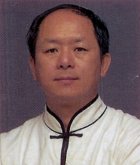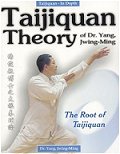From his recent interview with Lama Somananda Tantrapa…
“Between the ages of 9 and 12, I had almost no food. Taiwan was preparing for a war against mainland China. Most of us kids were starving.
There were nine children in my family, and at that time, feeding nine children was not easy. All our problems gave me an ulcer by the time I was 16 years old.
One day, I was sitting in the corner in a cold sweat. My White Crane Kung Fu master said I had a stomach problem. “What should I do?” I asked him. I had no medicine, and no money to see a doctor.
“At that time, in the early 1960s, you could not go learn another style without your master’s approval. It was not like today—people making ‘chop suey’ by mixing all these different styles.”
He said, “I’ve heard that Taiji can help you relax your internal organs.”
My master encouraged me to learn Tai Chi Chuan. That is the reason I started at the early age of 16. My motivation was not fighting; it was to ease the pain of my ulcer, and hopefully to heal myself.
Did it work? It surprised me. Six months later, the painful episodes had been reduced. After most of a year, they disappeared.
So that is why I started practicing Tai Chi Chuan. It is not because I liked it…I hated it, but it helped me to calm down.
Listen to the entire MP3 interview with Dr. Jwing-Ming Yang at Secrets of the Qigong Masters.


How ironic that few people can now afford to train taiji with Yang Jwing-Ming.
Similarly Mantak Chia began training because he had “low sex energy” yet ironically success is based on no male ejaculation! haha. The secret to relaxation is the vagus nerve of the female climax and the “stem cell” energy, as Mantak Chia states, is better than any food. But public sex is not cheap. haha.
http://www.i-sis.org.uk/Medicine_in_a_New_Key.php
Check out Dr. Mae-Wan Ho’s “Quantum Jazz and the Tao” articles as well — she discovered that chi is from POSITIVE charge — proton conductance — which explains why John Chang didn’t register on the meter tests of his healing energy.
Josh,
LOL. In the interview, he explains why he set up the YMAA retreat center. Apparently, some of the students there train for free (but in the end someone has to pay).
Drew,
Your interview is scheduled to go up tomorrow. Thanks for sharing.
I am well aware of the costs of attending and running his retreat. I have even spoken with him about the requirements for applicants.
His retreat is nice, but prevents anyone like him as a child from attending. The cost of attending for the better part of a year is nearly 20 thousand dollars.
Hello,
Im writing on behalf of Dr. Yang, Jwing-Ming. First, thanks to the host for this short article and the discussion.
The nonprofit Retreat Center is run by volunteers like myself, and is funded by private donations and by Dr Yang’s personal funds.
Dr. Yang has been very open about his finances throughout his career, and with the Retreat Center. There is a bizarre misconception that he is rich, but this is entirely incorrect. Not that its your business, or that someone should be penalized for making a living, but after teaching for 40 years, opening many schools around the world – many of which barely scrape by each year, and putting three kids through school, Dr Yang had a small savings for his retirement.
Full disclosure: http://ymaa-retreatcenter.org/news_events/2009/06/24/financial-summary-2008
Rather than retire, he put his entire life savings into the purchase of land and construction of the Retreat Center. He is over 60 years old – he teaches, starting at 5am, almost every day of the year. This center is being constructed for the benefit of the next generation. Dr Yang will be working during these last years of his life – not sitting around enjoying his retirement. He will not get rich from it. He has no interest in glory from it.
The Retreat Center exists to offer a chance to train in the ancient way, for a long period, without distraction.
Most of the donors are individuals who have benefitted some way from Dr Yang’s teaching, or who are living vicariously through the experience of these young students.
Of the 8 students presently training, only three are sponsored by sponsors or family. The rest are paid for by Dr. Yang. With insurance and food, it costs about $10,000 per student. New student applicants have been encouraged to find a sponsor, or afford their own insurance, but that is not always possible.
The students training at the Center, with one exception, are EXACTLY as Dr Yang was in his youth, with very similar backgrounds and poor finances.
People are invited to visit and join in the training, at a very reasonable fee, for SHORT periods (not a year for $20K). http://ymaa-retreatcenter.org/visiting Week-long seminars are also offered, again at a reasonable cost. http://www.ymaa.com/seminars/california
To imply that Dr Yang charges too much for training, after his decades of sacrifice, is inaccurate and unfair. People like Josh should spend less time complaining and disparaging other people’s hard work, and more time working, and training, and perhaps accomplishing things for the benefit of others.
David Silver
YMAA
(my own opinion, and not representative of YMAA)
I do not mean any disrespect – because I have the highest regard for Yang Jwing Ming – I have studied tai chi for eight years now and frequently refer to his books – but I have to ask: are there any studies regarding tai chi’s effects on health and illness? In part I honestly ask because if I were to see documented health benefits I maight seriously start training a lot more.
There are dozens of studies. You may wish to start from http://www.nytimes.com/2010/09/28/health/28brody.html:
This article is better than most, in that, instead of simply claiming that no valid scientific studies have been done, it points out that standard experimental controls have limited relevance, therefore a different set of standards must be applied.
Incidentally, the person who teaches Tai Chi at Tufts, and who designed this recent Tai Chi Fibromyalgia study with Dr. Chenchen Wang, is Ramel Rones, a senior disciple of Dr. Yang, Jwing-Ming since the early 1980s. Ramel has taken his traditional training into his “day job” as a mind/body consultant at Tufts, Harvard Medical School, Mass General Hospital, and Dana Farber Cancer Institute. He has been working for over a decade to bridge the gap between western medical science and the traditional arts of tai chi, meditation, and qigong, through several NIH studies.
Disciplined qigong practice helped me beat four bouts of supposedly terminal bone lymphoma in the early nineties (stage four disease, diagnosed ’91). I used it as an adjunct to chemo to calm my mind and body through the deep abdominal breathing, which also delivered more oxygen to my blood and pumped my lymphatic system, a key element of the immune system.
I learned standing post meditation and white crane qigong from the above-mentioned Rami Rones, disciple of Dr. Yang Jwing-Ming. Rami is a world-class martial artist and a gifted teacher; I was his first “cancer guy” and in the years since he has helped many to either beat the disease, live far longer than prognoses, or enjoy a better quality of life while enduring chemo and radiation.
Clear of cancer almost 15 years and still practicing an hour of standing post every day!
I started reading this and was dismayed about the first few comments.
So it was great to read the reply’s to these comments.
I also do not have much money but would love to train personally with Dr. Yang. As this is not possible at the moment
I buy a DVD occasionally and practice a lot on my own. ‘However good the teacher, ‘its always up to the student’
I deeply admire Dr. Yang’s work, teachings and look forward to many years of learning – even without one on one instruction. I would like to think we could have more respect for others – even on the internet.
Master Yang trained my Father in Boston many years ago. When computer first came out me and Son would play on it. It was upstairs with a black screen box and orange four letters. Master yang would ride me around on his shoulders feels like yesterday, but today I study quantum physics, particle physics, any and everything to understand why, and how I can control my heartbeat, body temperature, and the brain is a powerful thing. It surprises me quite often. I owe my life to him, I was at an adolescent age and my father made me train nonstop and instilled it in me. I first questioned everything when we were I felt my first tai chi ball while meditating. And as real as you and me, I can squeeze it you could feel it with nothing in between the 5 inches maybe nevertheless, I have survived things and accidents, and never broken a bone and question a lot of things I owe my life to him. Now I’m older, and I have studied many years to understand something that no one else understood in my world and it took me to quantum physics. I’m living proof of how powerful your mind is, but I could not understand why I could shield my body from 80 mile an hour impact that killed any and everyone Yet I walk out without a bruise and the feeling is hard to explain. Some people would say God angels, but after years of studying my brain development felt it knew it was real in the world that wouldn’t except it and I had no idea how much it impacted my future Without knowing but inside how to prove it’s real I purchased a thermal camera to show I could change body temperature wherever I wanted to within 10 to 20° on demand, to be honest it scared me the possibilities. Now quantum physics has proven even better than physics, that anything is possible. Master yang if you read this by any chance you might remember me, and my brother, there was a guy named Scotty to give you a hint. I used to love learning how to harness the power from your hips and groin area. Fa ging was the name and master yang would knock my dad and Scotty 5 or more feet and never change his posture he put one hang flat against chest and boom Like a whip from his feet to hips moved and like magic i thought and they would fly across the room. While yang never took one step. It all came clear when I studied thermodynamics. The first law is hard for many to comprehend, but it’s a fact, law I guess would be the word. I figure it out where to harness it from because it’s everywhere.